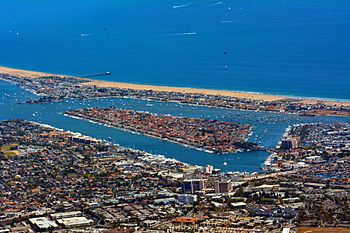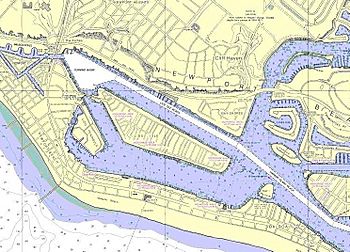Lido Isle, Newport Beach facts for kids
 |
|

Lido Isle, Newport Beach California
|
|
| Geography | |
|---|---|
| Location | Newport Beach, California |
| Coordinates | 33°36′45″N 117°55′00″W / 33.6126°N 117.9168°W |
| Area | 0.39 sq mi (1.0 km2) |
| Administration | |
|
United States
|
|
| State | California |
| County | Orange County |
| City | Newport Beach |
| Demographics | |
| Population | 1,800 |
| Pop. density | 4,600 /sq mi (1,780 /km2) |
Lido Isle is a unique man-made island located in the harbor of Newport Beach, California. It's surrounded by the city and became part of Newport Beach in 1906. When it was first created, it was mostly a sandbar and mudflat. Today, Lido Isle is a quiet place where about 1,800 people live. There are no big shops or businesses, just a small snack bar open in the summer. A single bridge connects the island to the rest of the city.
Contents
How Lido Isle Was Made
The name Lido comes from a famous beach in Lido di Venezia, Italy. In 1904, a man named Henry E. Huntington teamed up with William Collins. Huntington helped extend the Pacific Electric Railway to Newport Beach. In return, he received a large piece of land. This land included a mudflat, which was first called Electric Island. Later, it became Pacific Electric Island and then Huntington Island.
In 1923, a former railway conductor named W. K. Parkinson bought Huntington Island. He paid $45,000 for it, which would be about $747,000 today. Parkinson had made a lot of money from oil discoveries. He spent over a quarter-million dollars to dig out the harbor. The dirt from this digging was used to raise the island more than ten feet above the high tide line. A company was hired to build strong seawalls, a bridge, piers, and roads.
Designing the Island Community
Lido Isle was one of the first planned communities in California. It was designed to look like a fancy European resort. Parkinson wanted it to feel like the beautiful resorts in the Mediterranean region. After the harbor was dredged, the island was renamed Lido Isle. This name honored the Lido di Venezia near Venice, Italy.
Island Features
The island has only one bridge for cars and people to get on and off. It was also one of the first places in Southern California to have all its power lines and pipes built underground. This made the area look much neater.
To keep the Mediterranean theme, the streets on Lido Isle are named after cities in that region. You'll find streets like Barcelona, Genoa, Nice, and Ithaca. The two main streets are called Via Lido Nord and Via Lido Soud. There are about 800 homes on the island. About 250 of these homes are right on the water. Most houses are built in a Mediterranean Revival Style architecture, but some are Cape Cod or modern style.
Community Life
Lido Isle Club House
The Lido Isle Club House is the main gathering spot for the community. It's a "semi-private" place where many clubs and groups meet. It also has a snack bar and a small beach on the bay. Everyone who owns property on the island pays a yearly fee. This makes them members of the Community Association. The island also plays a big part in the yearly Newport Christmas Boat Parade.
Lido Isle Yacht Club
The Lido Isle Yacht Club started in 1928, but it became fully organized in 1947. The club's flag, called a burgee, combines two designs. It has a white flag with a red cross, like the Royal Yacht Squadron. It also has a blue anchor, like the South Coast Corinthian Yacht Club. The club's main goal is to teach young people how to sail. It also provides fun activities for everyone on Lido Isle. The club joined the Southern California Yachting Association in 1948. It was also accepted into the Yacht Racing Union of Southern California in 1965.
Images for kids
See also
 In Spanish: Isla Lido para niños
In Spanish: Isla Lido para niños





